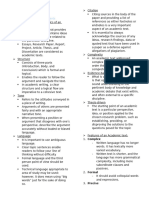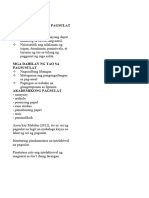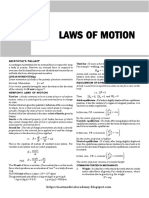Eapp Reviewer
Eapp Reviewer
Uploaded by
Gelu SyCopyright:
Available Formats
Eapp Reviewer
Eapp Reviewer
Uploaded by
Gelu SyOriginal Description:
Original Title
Copyright
Available Formats
Share this document
Did you find this document useful?
Is this content inappropriate?
Copyright:
Available Formats
Eapp Reviewer
Eapp Reviewer
Uploaded by
Gelu SyCopyright:
Available Formats
(EAP)English for Academic Purposes EVIDENCE BASED ARGUMENTS
the language and associated practices academic text is that opinions are
that people need in order to undertake based on a sound understanding of the
study or work in English medium high pertinent body of knowledge
education.
THESIS DRIVEN
FORMAL LANGUAGE (FORMALITY)
particular perspective, idea or position
no colloquialism and contractions applied to the chosen research
used for academic and professional problem
purposes
FEATURES OF AN ACADEMIC TEXT
INFORMAL LANGUAGE
COMPLEXITY
more casual and spontaneous
more lexical words than grammatical
SOCIAL (INFORMAL) uses longer, more complex phrases
sentences start with “but” and “and’ OBJECTIVITY
use of slang words; “guys” “cool”
emphasis should be on the information
ACADEMIC (FORMAL) use of the third person than first
more sophisticated vocabulary IMPERSONALITY
starts “however” “moreover” and “in
avoid making statements that are not
addition”
supported
NATURE AND CHARACTERISTICS
EXPLICITNESS
STRUCTURE
organization of the ideas
introduction, body, and introduction relationship and connection
academic writing a clear structure and indicates source of the idea
a logical flow are imperative to a
HEDGING
cohesive text
tentativeness and possibility
TONE
cautious or vague language
refers to the attitude conveyed have not acclaimed yet
describe the argument accurately
PRECISION
without loaded or biased language
specifying information, dates or figures
LANGUAGE
ACCURACY
use unambiguous language
Formal language and the third person free from grammatical error
point- of-view should be used. correct and appropriate words
CITATION SUMMARIZING- general idea in a brief form
essential to always acknowledge the 1. SOMEBODY WANTED BUT SO
source of any ideas, research findings, 2. STATE ASSIGN ACTION COMPLETE
data, or quoted text that have been 3. 5 W’S 1H
used in a paper as a defense against 4. FIRST THEN FINALLY
allegations of plagiarism 5. GIVE ME THE GIST
STRUCTURES OF PARAGRAPHS - Analyzes and discusses
- Contains recommendation
PARAGRAPHS
are a collection of sentences that deal
mostly with one topic or idea at a time
PARTS OF PARAGRAPHS
TOPIC SENTENCE
- presents the main point of the
paragraph
SUPPORTING SENTENCES
- support the main idea of the
paragraph
TRANSITIONAL SENTENCES
- pave the way to the next idea in the
next paragraph
CONCLUDING SENTENCES
- close out the main idea by summing
up the main idea
PATTERNS OF DEVELOPMENT OF
PARAGRAPHS
ILLUSTRATION
DEFINITION
CLASSIFICATION
COMPARISON AND CONTRAST
PROCESS
DESCRIPTIVE
STRUCTURING IMRaD
IMRaD
- Introduction, methods, results,
discussion, with a conclusion
- Explaining the topic and its intended
purpose
- Contains the context of the study
- Include the background of the study
- Aim(s) of the study
- Explanation of how aims were fulfilled
and answered
- Methods used to collect data and
ways to analyze data
- Research design of the study
- Objectively presents result
- Presents data using charts, figures,
and/or tables
- Reminds readers of the topic study
You might also like
- English For Academic and Professional Purposes PPT MIDTERMDocument59 pagesEnglish For Academic and Professional Purposes PPT MIDTERMMelprin CorreaNo ratings yet
- Kinetic Study of The Reaction Between Iron (III) Ions and Iodide IonsDocument11 pagesKinetic Study of The Reaction Between Iron (III) Ions and Iodide Ions门门100% (1)
- En 1493 2010 Vehicle LiftsDocument66 pagesEn 1493 2010 Vehicle LiftsEylül Özdemir100% (1)
- TankDocument480 pagesTankduelsky100% (2)
- Academic Language Used From Various DisciplinesDocument15 pagesAcademic Language Used From Various DisciplinesDeath the Kid100% (1)
- LESSON-1-ACADEMIC-LANGUAGE-USED-FROM-VARIOUS-DISCIPLINESDocument4 pagesLESSON-1-ACADEMIC-LANGUAGE-USED-FROM-VARIOUS-DISCIPLINESjechulichaenginyourareaNo ratings yet
- Eapp Quarter 1Document6 pagesEapp Quarter 1zoe dizonNo ratings yet
- EAPP MELCs Lesson 1 Copy For StudentDocument72 pagesEAPP MELCs Lesson 1 Copy For StudentAlthia Jean ResquirNo ratings yet
- EAPP LessonsDocument7 pagesEAPP LessonsKelly Misha NoolNo ratings yet
- EAPP ReviewerDocument7 pagesEAPP ReviewerNeil CapiliNo ratings yet
- Lesson-1-Nature-and-Characteristics-of-an-Academic-TextDocument18 pagesLesson-1-Nature-and-Characteristics-of-an-Academic-Textcorpuzmica27No ratings yet
- English AcadDocument3 pagesEnglish AcadDar LingNo ratings yet
- Eapp Exam ReviewerDocument5 pagesEapp Exam ReviewerKent BustamanteNo ratings yet
- REVIEWER EAPP (Monthly Exam)Document5 pagesREVIEWER EAPP (Monthly Exam)dbaldedomar.padriquezNo ratings yet
- Academic Language Used From Various DisciplinesDocument15 pagesAcademic Language Used From Various DisciplinesladyNo ratings yet
- EAPP LESSON 1 Nature and Characteristics of Academic Text - 033902Document3 pagesEAPP LESSON 1 Nature and Characteristics of Academic Text - 033902Angel PascuaNo ratings yet
- Lesson 1 English For Academic and Professional PurposeDocument4 pagesLesson 1 English For Academic and Professional PurposejealalynNo ratings yet
- Academic Language Used From Various DisciplinesDocument30 pagesAcademic Language Used From Various DisciplinesHwoarang TabernillaNo ratings yet
- EAPP01Document41 pagesEAPP01angelica peregrinoNo ratings yet
- EAPP-Reviewer 2Document5 pagesEAPP-Reviewer 2n5ct996hgdNo ratings yet
- Eapp FirstlessonDocument26 pagesEapp FirstlessonRosales Keian G.No ratings yet
- Week 1 NotesDocument3 pagesWeek 1 NotesjamesleysoncNo ratings yet
- ENGPROFDocument3 pagesENGPROFElisha De LimaNo ratings yet
- Week 1 Lesson 1 EappDocument21 pagesWeek 1 Lesson 1 EappzonNo ratings yet
- Eapp Q1 M1Document3 pagesEapp Q1 M1Crystal Maye LausaNo ratings yet
- Eapp Module 1Document5 pagesEapp Module 1MC Do100% (4)
- English NotesssssssDocument11 pagesEnglish NotesssssssLUCIA PELAYONo ratings yet
- Reviewer in Eapp - October '23Document2 pagesReviewer in Eapp - October '23Andrea TartarNo ratings yet
- Academic Language Used From Different DisciplineDocument20 pagesAcademic Language Used From Different DisciplineMarco MalasanNo ratings yet
- Eapp DiscussionsDocument27 pagesEapp DiscussionscapilijamesleysonNo ratings yet
- Lesson Plan 1ST SemDocument6 pagesLesson Plan 1ST SemArianne Jane PiastroNo ratings yet
- English For Academic and Professional Purposes 1st Long Test ReviewerDocument3 pagesEnglish For Academic and Professional Purposes 1st Long Test Reviewershadjoey0510No ratings yet
- Language Use in Academic WritingDocument31 pagesLanguage Use in Academic WritingerlynnipalNo ratings yet
- Eapp 1st Quarter NotesDocument9 pagesEapp 1st Quarter NotesDatoon JoemarieNo ratings yet
- Eapp Academic Language Used From Various DisciplineDocument67 pagesEapp Academic Language Used From Various DisciplineJboy Bahian BillanNo ratings yet
- Academic Text vs. Non-Academic TextDocument19 pagesAcademic Text vs. Non-Academic Textchocolove101424No ratings yet
- EAPP Lesson 1Document19 pagesEAPP Lesson 1Jhade ManatigaNo ratings yet
- Eapp Week 1Document57 pagesEapp Week 1Angelyn TrinidadNo ratings yet
- Lesson 1Document4 pagesLesson 1jhndmtvdNo ratings yet
- Fuck g12Document21 pagesFuck g12Elizabeth BandaNo ratings yet
- 1 - Lesson 1 English For AcadsDocument56 pages1 - Lesson 1 English For AcadsMark Kenneth L. De La CernaNo ratings yet
- Eap 2 Q3Document69 pagesEap 2 Q3Mis SyNo ratings yet
- English For Academic & Professional Purposes (EAPP)Document19 pagesEnglish For Academic & Professional Purposes (EAPP)Ella ParkNo ratings yet
- Eapp 1Document59 pagesEapp 1Clare SiplonNo ratings yet
- Academic VS Non-AcademicDocument3 pagesAcademic VS Non-AcademicFebe JamieNo ratings yet
- EAPP Learning Module 1 READING ACADEMIC TEXTSDocument5 pagesEAPP Learning Module 1 READING ACADEMIC TEXTSKianna Marie VitugNo ratings yet
- Eapp - Lesson 1Document12 pagesEapp - Lesson 1kristine collins YambaoNo ratings yet
- Academic TextDocument24 pagesAcademic TextLANCE FABRENo ratings yet
- Nature and Characteristics of An Academic TextDocument4 pagesNature and Characteristics of An Academic Textragaseurica23No ratings yet
- Lesson 1 Eapp 2024Document24 pagesLesson 1 Eapp 2024diannet075No ratings yet
- Soft Copy Eapp Lesson 1 3Document6 pagesSoft Copy Eapp Lesson 1 3xigebo7666No ratings yet
- Lesson 1 Academic Language Used From Various DisciplinesDocument23 pagesLesson 1 Academic Language Used From Various DisciplinesLoriely AmorantoNo ratings yet
- Eapp - Module 1 - Lesson 1Document50 pagesEapp - Module 1 - Lesson 1Rio Fionah LopezNo ratings yet
- Q1-Lesson 1Document35 pagesQ1-Lesson 1Nelissa Pearl ColomaNo ratings yet
- Eapp. Lecture1Document43 pagesEapp. Lecture1I am MystineNo ratings yet
- End of Unit 3 AssessmentDocument4 pagesEnd of Unit 3 Assessmentapi-377867134No ratings yet
- 5th Grade ElaDocument8 pages5th Grade Elaapi-325932544No ratings yet
- Academic Language Used Fro Various Disciplines: GroupDocument21 pagesAcademic Language Used Fro Various Disciplines: GroupcalyxdelfinNo ratings yet
- Module 1Document48 pagesModule 1NEAH SANTIAGONo ratings yet
- LAS EAPP12 Q1W1 RemovedDocument14 pagesLAS EAPP12 Q1W1 RemovedcortezmikhielajaneNo ratings yet
- Inbound 8154553630732892593Document125 pagesInbound 8154553630732892593Kyzelle PalapasNo ratings yet
- Eapp Reviewer Ni CaloyDocument5 pagesEapp Reviewer Ni CaloyCloud Stephen JindaniNo ratings yet
- Mushrooms, Electricity, and Neural Networks! - Herbal Visionz.Document22 pagesMushrooms, Electricity, and Neural Networks! - Herbal Visionz.nicungNo ratings yet
- Accord Fire Alarm Check ListDocument6 pagesAccord Fire Alarm Check ListFaruque SathiNo ratings yet
- Quantitative Ethnobotanical Study of Medicinal Plants in The Central Unit Barangays of Ligao City Albay PhilippinesDocument27 pagesQuantitative Ethnobotanical Study of Medicinal Plants in The Central Unit Barangays of Ligao City Albay PhilippinesOcean Derek L. RegondolaNo ratings yet
- Relativity106a Covectors Doppler EffectDocument76 pagesRelativity106a Covectors Doppler EffectKarabo LetsholoNo ratings yet
- 10.1201 9781315120782-2Document28 pages10.1201 9781315120782-2JAY CHHEDANo ratings yet
- Implementing Corporate Strategy: Managing The Multi Business FirmDocument15 pagesImplementing Corporate Strategy: Managing The Multi Business FirmArjay MolinaNo ratings yet
- Power System Simulation - Prof - Jain B. MarshelDocument72 pagesPower System Simulation - Prof - Jain B. MarshelRicuater GutierrezNo ratings yet
- 2021 年 9-12 月雅思口语 Part1 高频考题题卡 (初版)Document12 pages2021 年 9-12 月雅思口语 Part1 高频考题题卡 (初版)SANDYNo ratings yet
- Research ProposalDocument13 pagesResearch ProposalMohaiminul Islam100% (1)
- Study On Poly Bag ManufacturingDocument7 pagesStudy On Poly Bag ManufacturingSulemanNo ratings yet
- Oil Gas Ratings Guide February 2020 LECW2462 27Document92 pagesOil Gas Ratings Guide February 2020 LECW2462 27Zaka ZaheeriNo ratings yet
- Petrel 2014 Quick Start GuideDocument6 pagesPetrel 2014 Quick Start GuideDavid MontoyaNo ratings yet
- 2024 - Memorandum Maths - Grade - 11 PreDocument8 pages2024 - Memorandum Maths - Grade - 11 PrekgoshikhumaloNo ratings yet
- Seccion 4 - 8 Erick Villca PDFDocument156 pagesSeccion 4 - 8 Erick Villca PDFJulio Fernando Barrenoso AnglesNo ratings yet
- Fire Det 2nd Ed TocDocument12 pagesFire Det 2nd Ed TocJohn SmithNo ratings yet
- Presentation About EEE (For E1EEE) @RGUKT BASARDocument22 pagesPresentation About EEE (For E1EEE) @RGUKT BASARShivakrishnaNo ratings yet
- Laws of Motion-01Document34 pagesLaws of Motion-01wixirepNo ratings yet
- SWOT Analysis of Farook College Library: November 2018Document12 pagesSWOT Analysis of Farook College Library: November 2018Poetry By Sameem KhayalNo ratings yet
- Reaction Paper On UTSDocument5 pagesReaction Paper On UTSRyanVi100% (1)
- Biogas To Bio CNG Converter Machine Production PlantDocument10 pagesBiogas To Bio CNG Converter Machine Production PlantGanesh KhuleNo ratings yet
- MD110 Tech Guide HelpDocument335 pagesMD110 Tech Guide Helpladen10100% (1)
- 74HC154Document7 pages74HC154b4uspeacialNo ratings yet
- Research - Title DefenseDocument17 pagesResearch - Title DefenseBea NicoleNo ratings yet
- LAGD 15 Internal Audits For Laboratories and Inspection BodiesDocument12 pagesLAGD 15 Internal Audits For Laboratories and Inspection BodiesSelyun E OnnajNo ratings yet
- 5th Lecture PunctuationDocument8 pages5th Lecture PunctuationQadeerNo ratings yet
- StageFRAC With ClearFRAC XT - LV03 Operating Procedure 4544619 01Document60 pagesStageFRAC With ClearFRAC XT - LV03 Operating Procedure 4544619 01Jinhichi Molero RodriguezNo ratings yet
- Heavy Duty Body Builder Manual PDFDocument146 pagesHeavy Duty Body Builder Manual PDFBrian KittredgeNo ratings yet

























































































